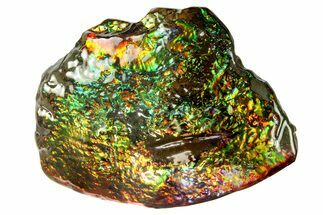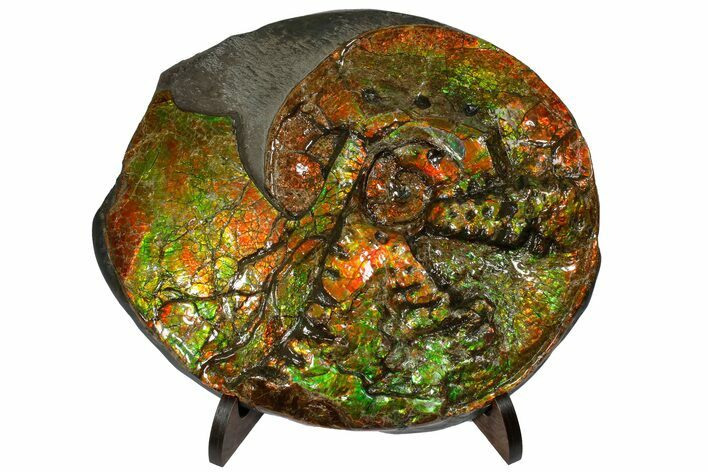This Specimen has been sold.
14.5" Spectacular Ammonite (Ammolite) With Mosasaur Bite Marks!
This is a truly fascinating ammonite of the species Placenticeras costatum, collected from the Bearpaw Shale of Alberta, Canada (collected Winter 2020). It's entirely preserved in ammolite, a brilliantly colored, opal-like gemstone and features perforations (bite marks) across the exposed face. These depressions resemble mosasaur bite marks, which is possible considering the age of these ammonite fossils. The iridescent colors in this specimen are brilliant, and depending on which angle you view them from, you may see red, orange, green and/or small spots of blue-purple coloration. It comes with a wood display stand to assist with aesthetic display of this stunning ammonite specimen.
Please contact us for any additional information about this specimen, payment or shipping.
Colorful Canadian ammonites are cherished by collectors and are on display at most of the prominent museums in the world.
These ammonites are rare. The Canadian government considers them part of the “National Treasures of Canada”. For this reason, all ammonites must be inspected and registered by the Alberta provincial government. Each ammonite then receives a number and is entered in the provincial database. A cultural property export permit is required for them to be exported from the province. All documentation will be provided with the specimen.
Please contact us for any additional information about this specimen, payment or shipping.
Colorful Canadian ammonites are cherished by collectors and are on display at most of the prominent museums in the world.
These ammonites are rare. The Canadian government considers them part of the “National Treasures of Canada”. For this reason, all ammonites must be inspected and registered by the Alberta provincial government. Each ammonite then receives a number and is entered in the provincial database. A cultural property export permit is required for them to be exported from the province. All documentation will be provided with the specimen.
Ammolite is an opal-like gemstone found primarily in Alberta, Canada. It is a kind of fossilized shell from ammonites, which in turn are composed primarily of aragonite, the same mineral contained in nacre (mother-of-pearl). The shell's microstructures are often preserved. In 1981, ammolite was given official gemstone status by the World Jewellery Confederation (CIBJO).
An iridescent opal-like play of color is shown in fine specimens, mostly in shades of green and red; howver, all the spectral colors can be seen. This iridescence is due to the aragonite's microstructure: unlike most other gems, whose colors come from light absorption, the iridescence in ammolite comes from interference with the light that rebounds from stacked layers of thin platelets that make up the aragonite. The thicker the layers, the more reds and greens are produced; the thinner the layers, the more blues and violets predominate. Blues and especially purples are the rarest colors, owing to the greater fragility of the finer layers responsible for these colors.
An iridescent opal-like play of color is shown in fine specimens, mostly in shades of green and red; howver, all the spectral colors can be seen. This iridescence is due to the aragonite's microstructure: unlike most other gems, whose colors come from light absorption, the iridescence in ammolite comes from interference with the light that rebounds from stacked layers of thin platelets that make up the aragonite. The thicker the layers, the more reds and greens are produced; the thinner the layers, the more blues and violets predominate. Blues and especially purples are the rarest colors, owing to the greater fragility of the finer layers responsible for these colors.
Ammonites were predatory cephalopod mollusks that resembled squids with spiral shells. They are more closely related to living octopuses, though their shells resemble that of nautilus species. True ammonites appeared in the fossil record about 240 million years ago during the Triassic Period. The last lineages disappeared 65 million years ago at the end of the Cretaceous.
SPECIES
Placenticeras costatum
LOCATION
Korite Ammolite Mine, SW Alberta, Canada
FORMATION
Bearpaw Formation
SIZE
14.5 x 12" wide
CATEGORY
ITEM
#181081
We guarantee the authenticity of all of our
specimens. Read more about our
Authenticity Guarantee.
specimens. Read more about our
Authenticity Guarantee.
 Reviews
Reviews



















